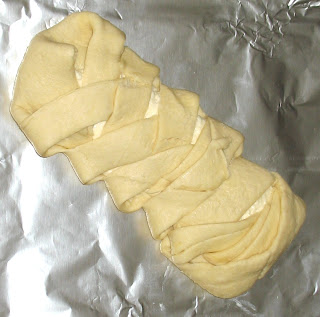If you have a can of crescent rolls and a package of cream cheese, you're in business.
Recipe after the jump!
Firstly, preheat your oven to 375 degrees (190 Cesius, for my Canadian friends) and line a cookie sheet with foil. Then, dump your ingredients into a mixing bowl.
8 oz cream cheese (softened)
1/2 c. powdered sugar
1 egg
pinch of salt
Mix these until they're smooth; set aside. Open your fridge and grab your can of rolls.
Unroll your cresent rolls onto a sheet of wax paper, but don't separate them. Pinch the seams together, like so:
Use a small, sharp knife to score the edges like I've shown here:
Don't fill it too full, just use about 80% of your filling.
Then fold the bottom part of the dough up and tuck it around the filling.
Begin "braiding" your dough, crossing one little flap over on one side, then the other, until you've gotten to the top. Fold the top of the dough over and tuck it around the other end of the filling. Carefully place your danish on your foil lined cookie sheet.
Bake at 375 for 15 minutes or so. While this is cooking, make your glaze.
1/2 c. powdered sugar
1/2 tsp. vanilla extract
1 TB milk
Whisk these together in a small bowl until smooth.
Left the foil with the danish on it from your cookie sheet and let it cool on a wire rack. This prevents the bottom of the danish from continuing to cook on the hot pan.
When it's cooled a bit, drizzle your glaze over it. Serve it for brunch and blow everybody's mind.

































